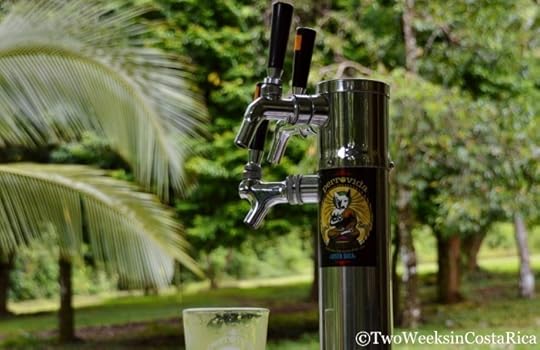Matthew Houde's Blog, page 33
March 18, 2015
San Gerardo Waterfall
Hidden among the quiet forests of San Gerardo de Dota lies a little-known waterfall, the San Gerardo Waterfall. Sometimes called the Rio Savegre Waterfall, this beautiful cascade is just an hour’s walk from town. While most people visit San Gerardo de Dota for the chance to see the iridescent feathers of a famous bird, the Resplendent Quetzal, the San Gerardo Waterfall is another nice diversion in this quaint town. Below is everything you need to know about visiting the San Gerardo Waterfall.

Location
The remote village of San Gerardo de Dota is located at the edge of Costa Rica’s Southern Zone in a valley high up in the cloud-covered mountains. It is between the surf town of Dominical to the south and the city of Cartago to the north. Because of its proximity to San Jose and the airport (about 3 hours away), those up for some adventure often take the mountain route to get to or from the capital and spend a couple of days in San Gerardo, either at the beginning or end of their trip.
Tip: Before heading out, be sure to inquire about road conditions on Highway 2 between San Isidro del General and San Jose. This stretch of the Interamericana Highway around Cerro de la Muerte where the mountain peaks is sometimes closed due to landslides and washouts. Check for road-closure notices on the Costa Rica Transit Police website (Spanish). Also, we do not advise driving this route after dark as cloud cover at such a high altitude makes visibility extremely limited.
Accessing the San Gerardo Waterfall
As you enter town along the one main road, you’ll notice the crystal-clear Savegre River. This is the river that flows alongside the road, through the forest, and leads to the San Gerardo Waterfall. To find the trail leading to the falls, keep driving through town until you see a gate and small sign on the left. The trailhead is towards the end of the road; if you pass Suria Lodge, you’ve gone too far.

Following the dirt trail, you’re likely to encounter some local fishermen heading to the river for the day. San Gerardo de Dota is on the cooler side due to its altitude, and trout fishing is one of the main industries. Lots of the fishing is done on a small scale, but there’s also a larger trout farm, which you’ll pass shortly after hitting the trail.

The easy-to-follow path meanders along the riverbank, leading through intensely green forest. As San Gerardo de Dota abuts the cloud forest, the trees are covered in thick ribbons of moss and lichen. Birds are everywhere too, and if you’re into bird-watching like us, be sure to bring your binoculars and charge your camera for some awesome shots.
While the trail is mostly flat, it isn’t all easy. We visited during the rainy season so there were some wet, slippery spots and lots of roots to watch out for. There is also a wobbly hanging bridge and a couple of other bridges that could use some repair. The bridges themselves seemed structurally safe, but some of the stairs leading to them had gaping holes. Luckily we had the best tour guide around to lead us safely across.

Watch out for those steps
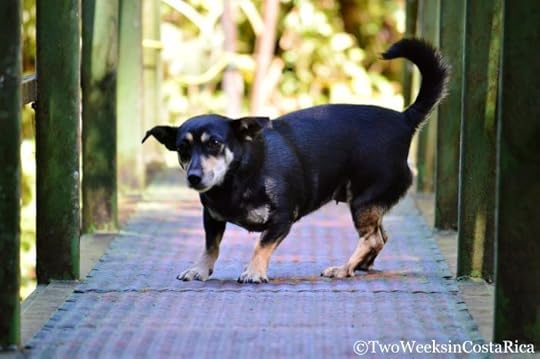
Our guide, an adorable local dog, that followed us the whole way
After walking for about an hour, you’ll come to a cave with a small waterfall rushing behind. In just a few minutes more, you’ll cross a bridge, walk down some steps (about 70), and arrive at the main attraction: the San Gerardo Waterfall. To get the best view, you have to climb down a boulder using nothing but a rope.


Matt maneuvering down the steep rocky ledge
The hike down wasn’t easy—Jenn didn’t make it without slipping—but luckily you can still get a nice view even if you don’t make it the whole way.
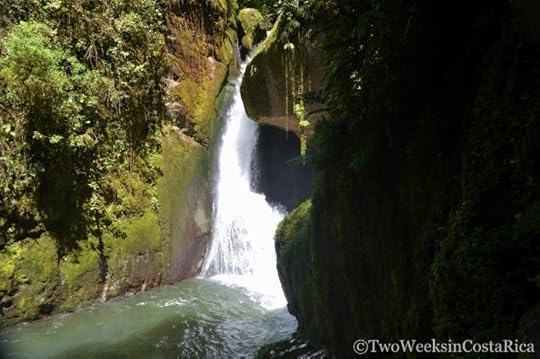
View from the half-way point
What to Bring/Wear
Hiking boots or sturdy sneakers
Lightweight pants and clothes for layering. Temperatures get into the 60s (16° C) at night and reach 75° F (24° C) during the day. It’s nice to have a jacket for the early morning.
Raincoat (it rains a lot in the cloud forest)
Water
For directions to San Gerardo de Dota, hotel recommendations, and more tips for visiting, check out our post, San Gerardo de Dota: A Hideaway in the Cloud Forest.

Costa Rica’s rainforest-rich Southern Zone is full of amazing waterfalls. From the remote Diamante Cave and Waterfall to the Nauyaca near Dominical, there’s something for everyone. But for those visiting San Gerardo de Dota, its namesake waterfall is definitely worth a visit.
Have you been to a waterfall in Costa Rica? Which is your favorite?
The post San Gerardo Waterfall appeared first on Two Weeks in Costa Rica.
March 12, 2015
A Jungle Night Tour with Tracie the Bug Lady
As the sun sets on the jungle of Drake Bay, the forest comes alive. Where only a few hours earlier there were birds and monkeys to see, suddenly a whole new world begins to creep, crawl, and slither into the night. We recently took a night tour through this mysterious world with Tracie the Bug Lady and felt like we were on the set of the Discovery Channel. This tour may sound scary at first, but if you like nature like us, you’re sure to be astounded at what you discover and learn. Here’s what you can expect.

Our tour began near the center of Drake Bay, a small village on the remote Osa Peninsula. Drake Bay borders a large swath of rainforest that is said to be one of the most biodiverse in the world. Even as we were standing there, learning how to operate our headlamps and being told some precautions to take while out on the trail, we could already hear the forest start to perk. Most noticeable were the small chirps from frogs and insects that got louder and more frequent as the sun began to set.
In Good Hands
It helped to know as we began our trek into the darkness that we were in good hands. Tracie and her husband, Gian, work as a team and have been doing night tours for over 10 years.
Our small group first met up with Gian. He’s an experienced guide who is passionate about wildlife, especially frogs and snakes. As he led us down a footpath from town to a nearby dock, he stopped to show us a roosting bat near the beach. Shining his flashlight into the palm tree above, Gian explained that this species was a tent-making bat and that they bend the leaves of plants to make themselves a nice little house. We also learned that this was one of more than 110 different species of bat found in Costa Rica alone!

Tent-making Bat
Next we crossed a small river by boat and met up with Tracie on the other side. Tracie is a biologist who is passionate about entomology. As we stood in a semicircle around her, Tracie indulged the group in her specialty—insects and spiders. We learned that wherever we looked there were tiny sets of eyes staring right back at us. The color, she told us, determined what it was. A green sparkle meant spiders, flecks of orange were moths, mammals shine a bright orange glow, and so on. As if by magic, a large beetle landed next to her and started flashing the two small dots on its back on and off like a signal light.

The Story Behind It All
The best part of the tour in our opinion were the detailed stories about each creature we encountered. Instead of just rattling off the name of a spider, beetle, snake, or frog and moving on, Tracie and Gian took turns teaching us why each one was special. We heard elaborate tales about a frog with toxic skin that may contain the next Viagra-like drug, a spider that literally casts a net like Spiderman, and a snake that can extend its body perfectly horizontal to reach the next branch and catch its dinner. One of our favorites was that first beetle that landed nearby, the bioluminescent click beetle. This little beetle might have changed the course of history, according to some journals.
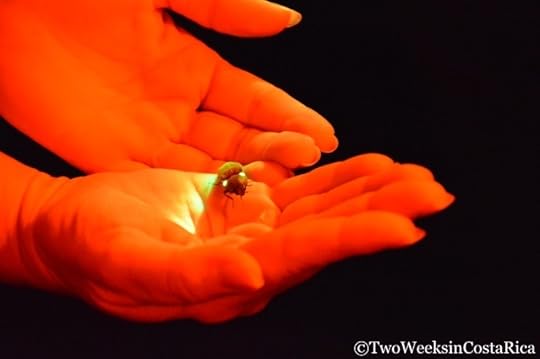
Tracie holding a Bioluminescent Click Beetle
The story goes that when the British were exploring and staking claim to territories in the Caribbean, they saw a lot of lights moving around on the island that is known today as Cuba. Thinking that the lights were the torches of Spaniards ready to fight, they fled and staked claim to Jamaica instead. The beetles had scared them off! To make these beetles even more fascinating, we learned that in some cultures, including in Mexico, they are placed in transparent cloth bags and pinned onto the dresses of young girls. The bugs act as a glimmering brooch, making these ladies literally glow for their special occasion.
A New Appreciation
As the night went on, it was hard not to become excited about everything we saw thanks to the enthusiasm of Gian and Tracie. Forget those science shows on TV that have you falling asleep on your couch, this was real life, right in front of us. Even the people on the tour who were squeamish about things like spiders and snakes seemed to relax a bit once they got to know more about the animals. This was especially evident when Tracie found a red-eyed tree snake next to the trail. She quickly grabbed the mildly venomous snake, held it high, and gave us a close-up view. The whole group, well just about everyone, was all smiles.

Tracie giving Jenn a mild heart attack
Even the night’s scariest looking creature, a tailless whipscorpion, had the group leaning in for a closer look. These guys might look dangerous but are almost completely blind and relatively harmless, we learned.

Tailless Whip-Scorpion
As we followed Tracie and Gian across a wobbly foot bridge, crossing over the river, we came right back to the place where we had started. Tracie explained that she and Gian do tours almost every night and they are always different. They find something new (even to them) every 10 days or so. Her point was that you never know what the night will bring and around every corner there is something exciting and exhilarating to discover. We left, walking down the trail to our cabin, with this philosophy in mind and a whole new appreciation for the creatures of the night. And yes, we saw plenty of mysterious sets of eyes sparkling and staring right back at us.
Information on Booking a Night Tour with Tracie the Bug Lady
Tour Times: Nightly at 5:30 and 7:30 p.m. (schedule may change during the low season, May through November). Advanced reservations are highly recommended as group size is kept small and this is a popular tour. Contact Tracie and Gian through their website for reservations: http://www.thenighttour.com/drake_bay_night_tour_reservation.htm
Duration: Approximately 2 hrs.
Price: $35/pp
What to Wear: Lightweight pants and closed-toe shoes.
Thanks to Tracie and Gian for hosting us on the tour. As always, all opinions are our own.
Have you been on a night tour through the jungle? What did you see?
The post A Jungle Night Tour with Tracie the Bug Lady appeared first on Two Weeks in Costa Rica.
March 4, 2015
Playa Blanca: A White Sand Oasis Near Jaco
When you think of beautiful beaches in Costa Rica, you probably think of the shell-filled Playa Conchal, the pristine Playa Flamingo, and maybe even Playa Punta Uva with its caramel-colored sand and lush jungle backdrop. One area that typically doesn’t come to mind is Jaco. But just a short drive from this bustling seaside town is a gorgeous white-sand beach called Playa Blanca (sometimes called Punta Leona) that is one of the prettiest we’ve seen in Costa Rica. Below is everything you need to know to plan your visit to this hidden gem.

Location
Playa Blanca is located just north of the town of Herradura on Costa Rica’s Central Pacific Coast. While just a 20 minute drive from the popular Playa Jaco, this beach is not well known among tourists. It is unmarked and many people think that you can access it only if you’re staying at the Punta Leona Hotel. This is not the case. Like all beaches in Costa Rica, Playa Blanca is open to the public. It is a bit hidden though so you do have to know how to get there.
Getting There
From Jaco or Playa Herradura, head north along the Costanera highway. Just before the Punta Leona Hotel, you’ll take a left onto an unmarked dirt road right before a small restaurant called Soda Nimar. Drive about 10 minutes along this road, passing by fields and then through parts of the resort. Along the way, security guards will take down your license plate number. If they ask, just tell them you are going to Playa Mantas (the beach right next to Playa Blanca). Near the end of the road, you’ll reach a small parking area. A guard will tell you where to park and will watch your car for the day for 2,000 colones (about $4).
Tip: Arrive early to get a parking spot. Although this beach isn’t well known by tourists, it is a favorite spot among locals and public parking is very limited. Ticos from the surrounding towns and nearby San Jose often hit up this beach for holidays and weekends. Sunday is typically the busiest beach day, followed by Saturday, so visit during the week if you can.
The first beach you’ll come to from the parking area is the gray sand Playa Mantas. This picturesque cove is also a nice place to spend the day if you can’t climb the rocks to get over to Playa Blanca. Playa Mantas is a calm cove so good for swimming and has lots of tall palms and thick shrubbery for shade.

Playa Mantas
For those wanting to experience Playa Blanca, you’ll have to walk a few minutes south to a point. Playa Blanca lies just on the other side of the point and the only way to get to it, unless you’re staying at Punta Leona Hotel, is on foot.
There are a couple of different ways to cross. At lower tides, you can climb the rocks on the far end of the point. This is the easiest way as the rocks are fairly flat. At higher tides, you’ll have to maneuver up a steeper embankment closer to the mainland. At the time of our visit, people had propped up a log to make the ascent a little easier, but it was still difficult to get up and down. Access it the other way at low tide if you can.

Access to Playa Blanca at high tide (more difficult)

Access to Playa Blanca at low tide. An easy walk across the rocks.
The Reward
Once you make to the other side, you’ll be well rewarded. With fluffy white sand, clear turquoise water, lofty palm trees, and even Scarlet Macaw parrots flying overhead, Playa Blanca is the epitome of tropical paradise. For us, it is the most beautiful beach we have found along this stretch of the Pacific Coast.

Tips for Visiting Playa Blanca
As the beach is a bit of work to get to, plan to spend at least a few hours if not the whole day. Bring along snorkel equipment if you have it for some casual snorkeling along the reef and rocks just offshore. Also be sure to carry whatever food and drink you’ll need for the day as there are no restaurants or amenities for the public.

We were thrilled to discover Playa Blanca during our recent stay in the Jaco area. This part of the country has mostly gray sand beaches and it can be difficult to find calm water for swimming, but Playa Blanca, with its pristine white sand and alluring water, was a welcome oasis.
What’s your favorite beach? Let us know in the comments below.
The post Playa Blanca: A White Sand Oasis Near Jaco appeared first on Two Weeks in Costa Rica.
February 23, 2015
FAQs About Moving to Costa Rica
We get emails all the time from people interested in moving to Costa Rica. They’ve been drawn in by the relaxed pace of life, beautiful scenery, and enviable climate. Some are ready to quit their jobs and pack their bags and haven’t even visited the country yet (don’t do this!). Because people typically have many of the same questions, we thought we’d put our thoughts together in one place. Keep in mind that we aren’t experts and if you asked 100 expats living in Costa Rica these very same questions, you’d get 100 different answers. But this information is enough to get you going in the right direction. Keep in mind that we’ve written separate posts on many of the topics, so be sure to follow the links provided. If you still don’t find what you’re looking for, feel free to ask a question in the comments below or in our Forum.

What Is the Cost of Living in Costa Rica?
It is expensive to live in Costa Rica (we find it similar to the US), but if you live simply, it can be affordable. Rentals start as low as $300/month and go up into the thousands. Near the beach in touristy areas costs the most. In the mountains and in rural areas where locals live is the cheapest. Groceries are comparable to the US but fresh produce is very inexpensive at farmers markets, which you can find in almost every community. Electricity is fairly expensive (again similar to what we used to pay in Boston) so take that into consideration if you’re moving to the beach and plan to use the AC a lot. Restaurants, except for those serving typical Costa Rican food, are about the same as the US. Cars are also very expensive due to high import taxes. As an example, a 15-year-old SUV like ours typically costs $8,000-12,000, depending on make and model. Gas is pricey too. If you’re willing to get around by bus, buses are cheap, fairly reliable, and can get you almost anywhere in the country as long as you have some patience. Keep in mind though, that in more rural areas, buses run less regularly (sometimes only 3 times a day). In and around San José has the most bus routes running regularly.
People often ask if a certain amount of money is “enough” to live in Costa Rica. This really all depends on where you want to live and your standard of living. If you’re going to be buying a lot of imported items at the Auto Mercado (grocery store with many North American products) and expect granite countertops, $2,000 a month isn’t going to cut it. For those of you who want a number, people who live like the locals in simple Tico-style houses and eat rice and beans regularly spend as little as $1,000 a month. More standard is $1,500-2,500, which gets you a normal, two-bedroom rental, eating out a couple of times a week, and splurging on something special once in a while. Again, prices vary by town and are the highest in popular tourist destinations.
Helpful Links on Cost of Living
Buying a Car in Costa Rica
Maintaining a Car in Costa Rica
Our Life in Costa Rica section: Lots of information on cost of living, especially our post on Where We’ve Lived in Costa Rica.
Retire for Less in Costa Rica: Paul and Gloria Yeatman give extremely detailed cost of living updates every month.
How Can I Afford to Do What You’re Doing?
If you’re retired and have enough money coming in, you should have no problem living in Costa Rica as long as you stick to a budget. But for younger people like us, it can be a challenge. The problem is that you’re not allowed to work in Costa Rica unless you’re a permanent resident (more on this below). What we did was have a long-term plan. While living in the US, we saved up for a few years before moving to give ourselves a cushion–both for living in Costa Rica and something to fall back on if we decided to move back to the US. We also had a loose plan for how we were going to make money in Costa Rica before coming. Originally we thought that we would start a small bed and breakfast or manage some vacation rentals. But after meeting others who were doing that, we decided that we didn’t want to be trapped in one place and unable to travel, something that we love.
We’ve since focused on travel writing and making money through our website. It has taken us a while but it’s finally starting to work. It isn’t easy though. Lots of people think they’re going to pick up and start a blog and make millions. In reality, there are thousands of travel bloggers out there (literally thousands, we’re serious) so you have to figure out a niche, something that makes you unique, and be really good at what you do. It’s a lot of work to write new content, respond to emails, keep up with social media, and figure out ways to make money, so only do it if you’re committed. For us, it’s a full-time job and then some, but not so bad because we get to live in Costa Rica.
For those of you looking for creative ways to save money, consider house sitting. We’ve been house sitting since we got here in July 2013 and have saved thousands of dollars in rent. In fact, we’ve only had to rent a few times in between house sits, which is phenomenal. Keep in mind though that house sitting isn’t perfect and isn’t for everyone. To get as many house sits as we’ve had, you have to be flexible with where you’re willing to go and for how long. Some of our gigs have been for one month, others four. It was great for us to be able to experience different areas of the country because our job is to travel and write about it, but it did get very tiring moving so much. Luckily we recently landed the dream gig: a long-term position that will keep us in one spot for at least a year!
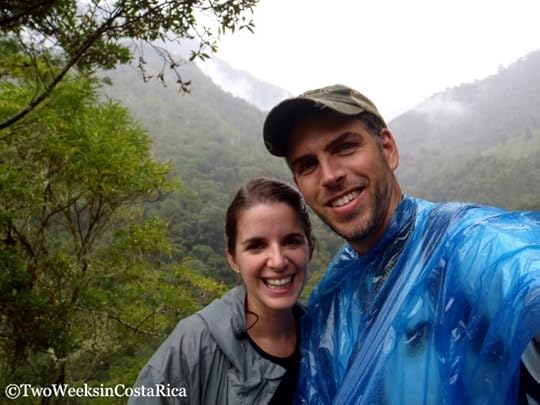
Exploring the cloud forest near Cerro Chirripo
If you’re interested in house sitting, there’s lots more info in our House Sitting category. In those posts, you’ll find info on how to get started, the sites that worked the best for us to get house sits, and lots more.
Where Should I Live?
When figuring out where you want to live, think about your ideal climate and how close you want to be to amenities. The beach is much hotter and more humid than the mountains, and for this reason, many people prefer to live in the Central Valley outside San José. The Central Valley and its surrounds (Grecia, Atenas, Heredia, etc.) are also closer to shopping, restaurants, and major hospitals. In rural areas, it can be more difficult to find things, there are fewer restaurants, and buses run less often so be sure to take this into consideration, especially if you don’t plan to buy a car.
We lived in eight different places during our first year in Costa Rica. Check out this post to hear our impressions of each town.
Wherever you decide, it’s best to rent first to try it out. A large percentage of people who move to Costa Rica leave within the first year or two, so before you completely turn your life upside down, visit a few different areas on vacation first. Then once you’ve picked an area you’re comfortable with, rent there for at least a year. That will allow you to figure out exactly where you want to live and feel out the climate in all seasons. We originally thought we wanted to live in Uvita near the beach but found out that it is really hot so love living in the nearby mountains where there’s a nice breeze. In most places the weather can vary even from one side of town to the other. In Grecia, for example (a popular expat town in the Central Valley), there are several ridges and the climate differs on each of them. Communities all have different quirks like this and until you spend some time there, you won’t know what’s right for you.
Tips on Finding a Rental: From our experience and from talking to other expats, it’s best not to commit to anything long term until you get to Costa Rica. Prices are often inflated online and through real estate agents, so if you can come down and talk to people in the community, you can usually find a better deal. Plus, you obviously have the benefit of seeing the house for yourself. A lot of people (us included) rent something very short term at first in the area they want to live, then start their search for a long-term rental when they get here.
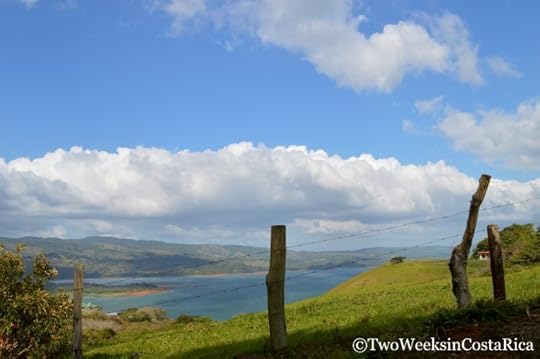
View of Lake Arenal from Puerto San Luis
How Do I Get Residency?
There are a few different ways to get residency. One involves proof of a certain amount of money coming in under a pension or retirement plan. Another also involves proof of funds coming in (non-pension/retirement) or you can make a large deposit into a Costa Rican bank account. A third relates to becoming a resident as an investor. Finally, you can become a permanent resident by marrying a Costa Rican or having a baby in-country. For more info on the specifics, check out the ARCR’s website. They help a lot of people moving to Costa Rica with residency, setting up bank accounts, etc. and have the most up-to-date information.
Some people start the residency process before moving while others wait until they get here. It is possible to apply for residency without an attorney, but if you don’t speak Spanish, you’ll need someone to translate the documents. We have yet to experience the adventure of applying for residency, but have heard that it can happen fast, in a couple of months, or very slow, up to a couple of years. It just depends.
When you come to Costa Rica, you typically get a 90 day tourist visa (the exact number of days is up to the immigration official but 90 is standard). That means that until you get residency, you have to leave the country every 90 days and upon returning, get a new 90 day stamp/visa. This has worked out fine for us, as it has given us a chance to do some traveling to Panama, Nicaragua, and elsewhere, but for many people it is a burden. Remember too that even after you’ve applied for residency, you still have to leave every 90 days if you plan to drive. Your non-Costa Rica driver’s license is renewed with your visa. Although once you apply for residency you don’t have to leave every 90 days anymore to fulfill immigration requirements, there’s supposedly some old law on the books that says you still have to renew your visa to keep your driver’s license valid.

Costa Rica-Panama border at Paso Canoas
What Kind of Jobs Are Available? How Can I Work in Costa Rica as a Foreigner?
You can’t legally work in Costa Rica unless you’re a permanent resident or citizen. There are exceptions to this rule but they are not common. Basically a company in Costa Rica has to show that there is no Costa Rican who can do the job so that’s why they need you. The company then gets a work permit for you through the government. It’s very rare.
So for most people, you have to become a permanent resident or a citizen. Becoming a permanent resident takes time, though, for most people. Unless you’re a first degree relative to a Costa Rican (through marriage or by having a baby in Costa Rica), you can’t get permanent residency without first being a temporary resident for a certain number of years. After that period, you can apply to be a permanent resident and can work legally for Costa Rican companies. Some people who move here do find businesses that will hire them even without the proper work permit. This of course is illegal and not a good way to start your new life here, especially if you get caught since you may be deported.
Working online is another option and what a lot of expats do. It is legal as long as the money is coming from a company or clients outside Costa Rica.
Is the Internet Reliable?
Internet varies across the country from a crawling less than one MB to a zippy 10 MB. Some towns have only a Wi-Fi connection (you connect with a 3G USB stick), which is generally less reliable. We’ve lived in several houses with 3G connections and the speed has been fine in some places and seriously slow in others. Cost is around $25-30/month for 2 MB speed.
If Internet is important to you, find a town that has cable Internet through Cable Tica or another provider. It’s much more reliable and you can pay extra to have a faster speed. The Central Valley is a good place to start, but many other communities have cable as well (e.g., Nosara; Manuel Antonio; Tamarindo; Lake Arenal area (Tronadora and Puerto San Luis); and Puerto Viejo de Talamanca, just to name a few).
One other thing to keep in mind: Don’t assume that just because most of a town has a 3G connection that you can’t get cable. If a hotel, development, etc. has paid to get a cable line put in, the houses near there might be able to access it too.
How Did You Get Your Stuff There? Suitcases vs. Shipping
You can either have your stuff shipped in cargo containers or just bring whatever you can fit on the airplane with you in luggage. There are pros and cons to both options. We brought our stuff in eight suitcases and it worked out great when we were house sitting. Now that we’ve moved into an unfurnished place though, we are having to buy a lot. Prices for furniture are a little higher than in the US but not shocking. The only problem for us has been finding what we need. Since we’re living in a more remote area, we’ve had to make some trips to San José and the nearest mid-size city to get certain things like a couch, good quality appliances, etc. Many houses are rented fully furnished in Costa Rica though, so if you are just “trying it out” for a while, you may want to keep your stuff back home and just bring the basics until you are sure.
Things to consider about shipping: If you ship, you’ll have to pay duties on what you bring. We don’t have any experience with shipping, but have heard stories of people having their belongings and car sit in customs for quite a while. There are several shipping companies out there. The Costa Rica expat Facebook groups are a good place to get a referral (see links at end of post).
What Should I Pack?
Check out these two posts for detailed info:
Our Eight or Ten Suitcases
Advice from Expats: What to Pack When Moving to Costa Rica
Should I Buy a Car There or Bring My Own?
Cars are expensive whether you bring your own or buy one here, but really nice if you want to see the country. You don’t have to be a resident to buy one; you just need your passport and an address in Costa Rica. For a detailed run-down of our car-buying experience, check out this post.
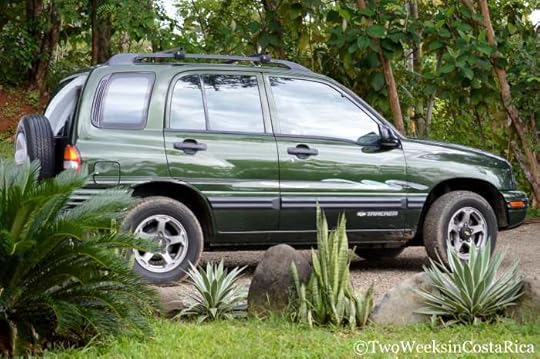
We sold our 2007 Civic Hybrid in Boston and got this 2000 Chevy Tracker in Costa Rica. The price for the Tracker, which is 7 years older, was about the same as what we got for our hybrid.
Instead of buying one here, a lot of people ship their old car from the US or elsewhere. This has its advantages as you know how the car has been treated. Many cars in Costa Rica have had a hard life, been beat up on rough roads, in floods or other natural disasters, and have even had their odometers turned back. Bringing your own ensures that you don’t get a $10,000 lemon, but it does have its disadvantages. The biggest is that you’ll have to pay import taxes to get it registered in Costa Rica. These duties are extremely high and can be 50-79% of the value of the car (not what you paid for the car but what the Costa Rica government deems it to be worth). So if you buy something for a few thousand dollars and pay for shipping and taxes, you might just end up spending about the same or more than if you bought a car here.
Useful Links
Our Life in Costa Rica category: Posts on our experiences living in Costa Rica, acclimating to the culture, buying a car, trying to learn Spanish, and generally settling in.
Association of Residents of Costa Rica (ARCR): Great forum for questions on moving, real estate, internet, phone, etc.
Facebook Expat Groups: There are several but a couple of really active ones are Expatriates in Costa Rica and Gringo Expats in Costa Rica. Areas with a big expat population often have town-specific groups too so be sure to do some searching. These groups are a great place to ask questions to those who know it best.
Books: There are a lot of books on living in Costa Rica as an expat. Here’s a link to some of our favorites.
Still have a burning question? Ask us below or on our Forum.
The information in this post is provided for informational purposes only and is not intended to be legal advice. While we have tried to ensure that the content is accurate and current, we make no guarantees. You should seek legal or other professional advice before acting or relying on any of the information.
The post FAQs About Moving to Costa Rica appeared first on Two Weeks in Costa Rica.
February 18, 2015
Making Organic Chocolate at La Iguana Chocolate
Among fields of pineapple and palm is a different kind […]
The post Making Organic Chocolate at La Iguana Chocolate appeared first on Two Weeks in Costa Rica.
February 13, 2015
Jaco: Costa Rica’s Booming Beach Town
Many people come to Costa Rica to turn everything off and just relax. Others are looking to do a lot of activities, get out on the town, and of course take in the country’s famous beaches and lush jungle. If the latter sounds like you, then Jaco might just be the perfect fit. In this post, we’ll cover everything you need to know about this popular Pacific Coast destination, including our picks for the best activities, beaches, restaurants, and hotels.

About Jaco
Located less than 1.5 hours from Costa Rica’s Juan Santamaria International Airport (SJO), Jaco is the closest major beachside destination to the capital city of San Jose. With rolling green hills of jungle and farm pasture in the distance, Jaco sits in a wide cove with rocky points on each end. The beach is a long gray arc that has a backdrop of palm trees, surfside hotels, souvenir and boutique shops, a huge selection of restaurants and bars, and the occasional mid-to-high-rise condo complex.

Jaco is considered to be one of Costa Rica’s most developed beach towns and the main strip, which runs adjacent to the sand, is bustling, both day and night. The town has developed a reputation over the years for its party atmosphere (mostly in the bars) and adult-only nighttime activities, but in recent years has put a lot of effort into making it an attractive place to visit for everyone, including families. There are some parks, jungle gyms, and lots of restaurants with kid-friendly menus around town. Many of the families visiting Jaco are actually locals who live near San Jose and flock to the beach on weekends, vacations, and holidays, injecting a nice mixture of local culture into the otherwise touristy town.
Activities in Jaco
One of the main draws of Jaco is the seemingly endless list of activities available. Everything from ATV and zip-line tours to catamaran cruises, scuba expeditions, and sport fishing can be booked from one of the tour operators in town. Out of the many things to do, here are a few of our picks.
Sunset Cocktails at Villa Caletas
North of Jaco on a tall ridge overlooking the scenic Gulf of Nicoya and Pacific Ocean is an amazing spot to take in the sunset over a tropical drink. Hotel Villa Caletas has built a dramatic outdoor amphitheater into the side of the cliff that makes you feel like you’re on top of the world. You don’t have to be a guest to experience this unique setting; just tell the staff you’re there for sunset and grab a drink from the bar.

The amphitheater at Villa Caletas
Surfing
Costa Rica is well known for its great surf, and the Jaco area is definitely one of the country’s hot spots. Surf shops are scattered all around town so it is easy and affordable to rent a board or take a lesson. At Playa Jaco, the smaller waves are perfect for learning or shaking off the rust if you haven’t been out in a while. For the more advanced, there’s Playa Hermosa just to the south. This world-class surfing beach is known for having the most consistent waves in the country. It’s not uncommon to see surfing professionals practicing or even competing in one of the many tournaments held at Hermosa.
Carara National Park
You wouldn’t expect it so close to a highly developed town like Jacó, but just to the north and stretching into the mountains is a vast expanse of pristine rainforest. Carara National Park has a small network of trails that lead through primary and secondary forest. They even have a newly renovated loop that is handicap accessible. Along any of the trails, you can see wildlife like monkeys, leaf cutter ants, and lots of birds. In fact, Carara is considered to be one of the best birding spots in Costa Rica with over 400 different species identified.

Thick rainforest at Carara National Park
Tarcoles River Boat Crocodile Tour
On your way to Jaco, you will pass a bridge with crowds of people leaning over and looking down. Basking along the banks of the Tarcoles River below, you’ll find huge crocodiles. While the bridge is decent spot to watch the crocs, even better is taking a boat tour up the river. We really enjoyed this tour because not only do you get very close to the crocs, but there are amazing views and you get to see a lot of birds and other wildlife too. Read more about our trip with José’s Crocodile River Tour here.
Jaco Farmers Market
If you’re staying in town for a little while, you might want to consider hitting up the weekly farmers market. Here you can get the freshest fruits and vegetables as well as artisanal breads, cheeses, and other goodies. The farmers market or feria as it is called locally is held every Friday morning off the south end of the main way, Avenue Pastor Diaz. If you’re coming from the center of town, turn right at the Palacio Municipal, then take another right near the Post Office.

Beaches
The main beach in town isn’t one of Costa Rica’s most beautiful, but its convenient location makes up for it. Located just a couple of blocks from the souvenir shops and restaurants lining the main strip is the gray sand Playa Jaco. This beach fills up fast with people sun bathing, strolling, people watching, or just hanging out. Jaco Beach isn’t the best for swimming, but luckily there are plenty more beautiful beaches in the area to explore.
Playa Herradura
Just 8 km (5 miles) north of Jaco is a sheltered cove that is known for the nearby marina and resort, Los Suenos. Playa Herradura is a little rocky but is a great spot for families because of its calm waves and playground. Parking is available right off the sand for a small fee and there are also a few local restaurants where you can grab a simple meal.
Playa Mantus and Playa Blanca
If you’re planning a full beach day, head to Playa Mantus and Playa Blanca. Located a little farther north of Playa Herradura, these beaches are well known to locals but not to tourists as they’re not clearly marked. To get there, head north along the Costanera highway, then take a left onto a dirt road right before the small restaurant, Soda Nimar, near the Punta Leona Hotel. Follow it to the end, passing through the resort, to a small parking area ($4). From there, you can walk out onto Playa Mantus, a picturesque cove with gray sand.
At lower tides, you can keep walking south, crossing some rocks and a point to access the beautiful white sands of Playa Blanca. In our opinion, Playa Blanca is the most beautiful beach in the area with clear water, fluffy sand, and lots of trees for shade. These beaches are very popular with the locals so get there early (and avoid weekends) to get a parking spot; it fills up fast! There are no restaurants or amenities for the public at Playa Mantus or Playa Blanca so be sure to bring everything you need for the day.
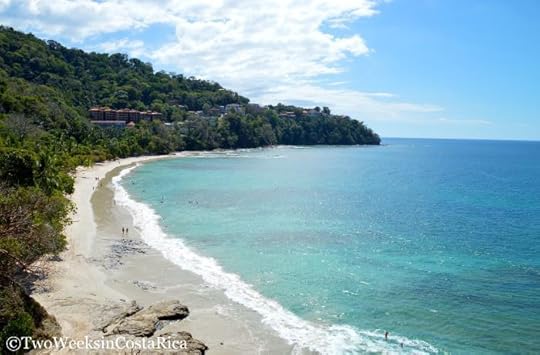
The gorgeous Playa Blanca
Playa Hermosa
Eight kilometers (5 miles) to the south of Jaco is the famous surfing beach, Playa Hermosa. Even if you aren’t a surfer, it’s worth a visit to this 7 km (4 mile) long stretch of sand. The majority of Playa Hermosa is empty with no development, but there is a small community with some restaurants, surf shops, and hotels on the northern end.
Playa Esterillos Oeste
If you’re looking for a secluded beach, keep heading south past Playa Hermosa about 15 km (9 miles) and you will come to Esterillos. There are multiple entrances off the main highway, but the one for Esterillos Oeste is a good place to find the shade of a palm tree, some peace and quiet, and nice waves if you’re into surfing. This area is not developed much at all but has a mini-supermarket and a couple of small sodas (typical Costa Rican restaurants).
Jaco Restaurants
The restaurant scene in Jaco is really taking off. Expert chefs are moving into town, and wine bars, vegan restaurants, and even pop-up supper clubs are springing up. The Jaco area has around 100 different restaurants serving everything from typical Costa Rican fare and bar basics, to gourmet cuts of beef and other gastronomic delicacies. Luckily for us, we got the inside scoop on the best places to eat from a few locals, including hospitality specialist Jon Hochstat. Here’s a selection of what we enjoyed to get you started. Note: Many of the directions below mention the POPS building. We use this as a point of reference because like most towns in Costa Rica, Jaco doesn’t use standard addresses. POPS is an ice-cream shop near the center of the strip. You can’t miss it.
Side Street Bistro
This was probably our favorite lunch spot in Jaco. Side Street offers gourmet sandwiches made with quality ingredients that come with sides and either iced tea or lemonade included. They also have a selection of craft beer, artisanal sodas, and for Sunday brunch—bottomless mimosas! They’re a little hidden outside town, but have a great location with a nice patio just a block from the ocean. $8-12. Kids menu available. Open 11 a.m. – 6 p.m. Mon. – Thurs., and until 9 p.m. on weekends and starting at 10 a.m. on Sundays. Located on the northern end of town, down a side road (road is across from Century 21). 300 meters south of Best Western.

Los Amigos
A chill spot right in the middle of everything is Los Amigos. Los Amigos has a large and varied menu with burgers, wraps, salads, Thai food, and their innovative Tropi rice bowls (recommended). It’s a good place for families. Los Amigos shows football and other games, and has events like live music and late night surf parties. $8-12. Take-out available. Open for lunch and dinner. Happy hour drink specials 4-7 p.m. Ave. Pastor Diaz. At the intersection across from POPS.
Graffiti Restro Cafe + Wine Bar
Our pick for a nice dinner out, Graffiti has a cool, contemporary atmosphere that will make you temporarily forget that you’re in Costa Rica. They specialize in “slow food” meaning that they use only local ingredients and their dishes take a little extra time to prepare. Not to worry, their innovative apps and selection of signature martinis (the cucumber and basil was great) will help tide you over. Chalkboard dinner specials include lots of choices for surf and turf, and the standard menu has burgers and lighter options like tapas, fish tacos, and flatbreads. $10-25. Dinner only. Closed Sundays. Call ahead for reservations. In the Pacific Plaza off the northern end of Ave. Pastor Diaz, behind Remax.
Rustico
For an authentic taste of Costa Rica, head to Rustico. This simple soda (typical Costa Rican restaurant) serves up tasty plates of rice, beans, meats, and sides in a casual buffet style. If you like beef, definitely try their Carne en Salsa. This place is popular with locals and hungry surfers so don’t be surprised if you see a line. $5-8 for most plates, includes a drink. On a side street off Ave. Pastor Diaz going to the beach (look for a billboard for Hicaco Restaurant).
The Pizza Shop
Good pizza is surprisingly hard to find in Costa Rica, but the Pizza Shop knows how to make a great pie. Crispy thin crust and a well-balanced sauce were the highlight but the toppings are what knock it out of the park. Homemade items like sausage, ricotta, and a balsamic reduction are just a few of the choices. They also have sandwiches but we’d be hard-pressed not to get the pizza again. Large pizzas $16-20. Sandwiches $7-9. Check out their Facebook page for the menu. Just south of the small yellow bridge on Ave. Pastor Diaz in the Paso Los Americanos building near Budget Rental Car.
Pajara Pinta
For healthy and vegetarian options, Pajara Pinta is the place to go. Pajara Pinta features homemade pasta, wraps, salads, and desserts. Make sure to ask for some of their special hot sauces to kick things up. They also have a smoothie and juice bar. Gluten free options available. $10-15. Open for all 3 meals. Closed Tuesdays. Ave. Pastor Diaz. Across the street from POPS. First floor of the large red building.
Green Room Cafe
What we liked most about the Green Room was the atmosphere. As soon as you walk in the door, you feel comfortable. Grab a seat outside in the terrace garden if you can. The Green Room focuses on local and organic ingredients and has delicious locally made craft beer. This hip spot often features live music; check out their Facebook page for details. $8-20. Happy hour Tues. – Sat. 5-7 p.m. Open for brunch/lunch and dinner. Closed Mondays. Ave. Pastor Diaz, across the street from POPS.
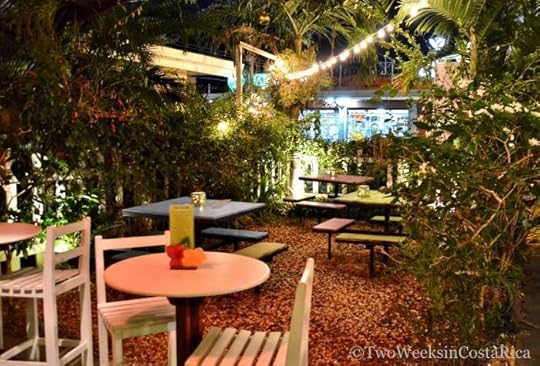
Outdoor space at Green Room
Lemon Zest
This is one restaurant that we haven’t made it to (yet) but that was highly recommended to us. Lemon Zest is known for having exquisite international cuisine and top notch service. They have daily specials, but everyone raves about the chef’s specialty, the duck with blackberry sauce. They have a nice wine list too. $15-30. Ave. Pastor Diaz. Just south of the Mas x Menos Supermarket. Upstairs in El Jardin Plaza.
Heladeria el Barco
For dessert or just a mid-day treat, stop by Heladeria el Barco for really good homemade gelato. Flavors are constantly rotating but there are at least 20 to choose from. Our favorites were hazelnut, chocolate, and coffee. Ave. Pastor Diaz, a few doors south of POPS.
Panaderia Artesanal
This isn’t your ordinary Costa Rican panaderia. With a lot more than just pastries, this artisanal bakery makes fresh bagels, breads, and of course lots of yummy desserts. They also serve coffee and espresso, a traditional Costa Rican breakfast, and have a lunch menu with a selection of sandwiches and wraps. $5-10. Northern end of Ave. Pastor Diaz in the Palm Plaza. Across from Economy Rent a Car.
Kokomos
This super chill new bar and restaurant right on the main strip is a great place to grab a happy hour drink and some appetizers. When we were stopped in (multiple times), Kokomos had a $1 margarita special from 4-7 p.m. Ave. Pastor Diaz, about two blocks south of POPS.

Jaco Hotels
Like restaurants, there are a ton of hotel options to choose from in the Jaco area. You can find everything from shared-room hostels for $20 dollars a night to luxurious suites for upwards of $400. Below are some of our recommendations in the different price ranges.
High End ($200+)
Los Suenos Marriott Ocean & Golf Resort
Spread out on 1,100 acres, Los Suenos is one of the only all-inclusive-style resorts on this stretch of Costa Rica’s Pacific Coast. This sprawling complex has six restaurants and lounges, easy access to the beach, a grand pool, an 18-hole golf course, a marina, a small grocer, and even some shops. With everything you need on-site, there’s really no reason to leave the immaculate grounds. The Marriott Los Sueños is located in the beach community of Playa Herradura, just north of Jacó. $200-400. Check Availability and Prices Here.

Photo Credit: Marriott Los Suenos
Hotel Villa Caletas
Villas Caletas is a luxury boutique hotel located high on a bluff and built in traditional Victorian style with a tropical spin. Surrounded by lush rainforest, the property is secluded and private. When we visited recently for sunset cocktails, hotel guests looked quite pleased with the infinity pool overlooking the Gulf of Nicoya. Some suites have their own plunge pools and access to a private beach is also available. Rooms have ocean, pool, or jungle views and the property is spread out so be sure to inquire when booking. Villas Caletas is located north of Playa Herradura and about a 10-minute drive off the highway. Consider renting a car if you want to explore the area. $200-400. Check Availability and Prices Here.
Mid-Range ($100-200)
Hotel Pumilio
For more affordable luxury, consider Hotel Pumilio. Pumilio is a smaller hotel set in the jungle between Jaco and Herradura on the inland side of the coastal highway. It has a nice pool and well-manicured grounds. The staff is very friendly and pride themselves on hospitality. Guests are even greeted with a glass of wine upon arrival. There is no restaurant on-site, but a myriad of choices are located about 5-10 minutes away in Jaco. Rooms also have an outdoor kitchenette if you’re inclined to cook. Lower rooms have direct access to the pool via a private terrace. $100-200, includes breakfast. Check Availability and Prices Here.

Photo Credit: Hotel Pumilio
Hotel Tuanis
This hotel on the southern end of the beach is a great value for the Jaco area. It is located on a side street right off the main way in Jaco, making it within walking distance to the beach, restaurants, and shopping, but far enough from the hustle and bustle of Avenue Pastor Diaz. Hotel Tuanis is a small, family-run place with accommodating, helpful staff. It’s eco-friendly with solar panels and dual flush toilets, but also offers A/C, good for those steamy days. All rooms have a refrigerator and some have kitchenettes. $60-100 for double occupancy. Check Availability and Prices Here.
Budget ($80 and under)
Hotel Perico Azul
Located about 15 minutes outside town, Hotel Perico Azul offers simple, clean rooms for an affordable price. Ideal for surfers, this cozy aparthotel is within walking distance to the beach. Surf lessons can be easily arranged as the owners also run Tortuga Surfing. One bedroom studios and standard rooms are available. Some have A/C and a kitchenette; there is also a well-equipped common kitchen. $65. Check Availability and Prices Here.

Photo Credit: Hotel Perico Azul
Room2Board Hostel and Surf School
The nicest hostel in the area is probably the new Room2Board. This boutique hostel and surf camp is at the southern end of the main drag. It has hotel-like amenities, including a movie-theatre room and rooftop bar with hammocks, and is less than a 5 minute walk to the main area of town and right on the beach. Private and shared rooms are available as well as less expensive dorm rooms. Surf and SUP packages available. $22-80. Check Availability and Prices Here.
Hotel de Haan
Hotel de Haan is a hostel with decent amenities and a fantastic location. It is just 100 meters from the beach in the middle of Jaco, has a pool, shared kitchen, Wi-Fi, hot showers, and fans. Dorms and comfortable private rooms are available. Get a room upstairs if you can for a better breeze. Beds start at $10. Check Availability and Prices Here.
* * *
As you can see, Jaco, Costa Rica is a booming destination with tons of things to see and do. Good for foodies, adventure seekers, surfers, shopping enthusiasts, and those who just want to sit on the beach and relax, Jaco is a place where you can easily spend a week or more. If you do want to explore, another great thing about Jaco is how close it is to other destinations. In just an hour, you can be on the beautiful beaches of Manuel Antonio, and in another hour more, the rainforest-covered Costa Ballena. But with so much going on in Jaco, we doubt you’ll stray far.
Have you been to Jaco? What did you think?
The post Jaco: Costa Rica’s Booming Beach Town appeared first on Two Weeks in Costa Rica.
February 4, 2015
Rainmaker Conservation Project: Unspoiled Nature Near Manuel Antonio
Everyone knows about Manuel Antonio’s famed national park, but if you’re looking for something more off-the-beaten path, there’s another great option. Rainmaker Conservation Project located just outside Quepos is a private nature reserve with hiking trails, hanging bridges, waterfalls, and tons of birds and wildlife. Below are our tips for exploring Rainmaker on a day trip from Manuel Antonio or Quepos.

History of Rainmaker Conservation Project
Before we share the details of planning your visit to Rainmaker Conservation Project, it is worth hearing about the project’s fascinating history that spans 25 years.
Sometime around 1990, a farmer named Don Victor Fallas needed some cash so was looking to sell a portion of his land near Parrita. A Costa Rican named Mauricio Gutierrez entered the picture and agreed to purchase 200 hectares (500 acres) on behalf of the company the Body Shop, which wanted the farmland to grow products for use in their cosmetics. Don Victor also owned a large amount of primary rainforest on a nearby mountain. Though he needed to sell it because of his debt, he wanted to find someone who would keep it preserved. Mauricio shared a similar vision and agreed to buy 2,000 hectares (5,000 acres) of the forest in his own name, thinking the pristine land could be valuable in a future tourism business.
Just as the paperwork was being finalized, Mauricio died tragically in an accident when he fell into a waterfall on the property while trying to save a child. With no buyer, the deal was about to fall through when Mauricio’s wife, Ann Gutierrez from the US, stepped in. She didn’t have the cash upfront but somehow got Don Victor to agree to a five-year mortgage. The only problem was that Don Victor wanted $100,000 as a down payment—and he wanted it in a week. The story then goes back to the Body Shop. Ann contacted Gordon Roddick, co-founder of the cosmetics giant, who agreed to lend her $100,000 for the down payment, and the deal went through.
Today the land is completely paid off and preserved. If it hadn’t been for Ann and her children Alessandra and Mick stepping in, the land probably would have been turned into a lumberyard. Apparently the bank that owned the property was in talks with a Japanese wood company that was set to buy the land if Don Victor defaulted on his loan. After visiting the property and seeing for ourselves how special it is, we can really appreciate Ann, Alessandra, and Mick’s efforts to keep Mauricio’s vision of conservation alive.
What to Expect on Your Visit to Rainmaker Conservation Project
The Trails
Rainmaker Conservation Project has a 2.5 km (1.5 mile) trail system that passes waterfalls and runs alongside a beautiful winding river. The tract of land is primary rainforest, meaning that it has never been cut down. The old growth trees and topography of the reserve create spectacular, majestic views that are hard to match. We’ve done a lot of hiking in Costa Rica and found Rainmaker to have some of the best views around. The way the trees tower along the mountain creates almost a wall of rich, green forest.
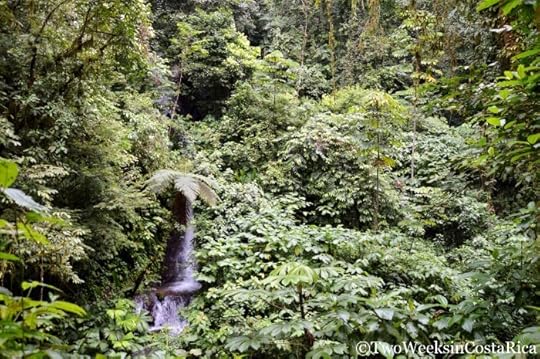
In terms of difficulty, the main loop is moderate and suitable for most people, though there are some areas that are steeper and slippery. Short loops off the main trail are more difficult and climb farther up the mountain to a lookout and a series of suspension bridges. These hanging bridges are suspended high above the ground, giving you a unique vantage point from which to observe the rainforest. They are narrow and rickety, so if you’re afraid of heights, you might want to skip them.

Just outside the area where you buy your tickets is a large sign with the trail map detailing where the hanging bridges are located and the best spots for swimming. Click here to view the map.
The Wildlife
Because it is a bit out of the way, Rainmaker sees a lot less foot traffic than the often busy Manuel Antonio National Park. This means that you’re more likely to have the trails all to yourself and see more wildlife. More than half the plants and animals that live in Costa Rica can be spotted at Rainmaker. On our visit, we saw a green and black poison dart frog, a whiptail lizard, and several kinds of butterflies including a glass-winged variety. We also saw lots of birds, including a Chestnut-mandibled Toucan, Blue-crowned Manakin, Black-throated Trogon, and Baird’s Trogon.

A Craft Beer Bonus
You wouldn’t expect it in such a remote area, but right on the Rainmaker property some delicious craft beer is being made. Ann’s son, Mick, started Perro Vida Brewery along with another guy and they make delicious craft beer right on site. This is a very small operation so don’t expect an elaborate tour but the beer is some of the best around. Offerings depend on what they’re brewing, but we got to sample four of their beers, including the ultra hoppy Diogenes Double IPA and Massive Mastiff Black Imperial. Their brews are available in select bars and restaurants in Costa Rica if you want to enjoy some later on as well. You can usually find some at Barba Roja in Manuel Antonio.
Planning Your Visit to Rainmaker Conservation Project
What to Wear/Bring
Hiking boots or sturdy sneakers
Bathing suit for swimming in the natural pools
Plenty of water
Bug spray, especially if you’re visiting during the rainy season (May through November).
Cost: $20 for a self-guided tour. Most people visit on their own but guides can be arranged in advance through Rainmaker, or through a tour company in Manuel Antonio or Quepos. Rainmaker also offers a traditional Costa Rican lunch for $5.
Hours: Daily 7:00 a.m. to 6:00 p.m.
Directions
Rainmaker is located about 20 minutes off the Costanera highway, Route 34, in the village of San Rafael Norte near the town of Parrita. At the time of our visit, it was signed in only one direction (look for the Paintball sign if there isn’t one for Rainmaker). The road leading to the reserve is dirt. Four-wheel drive is not required but would be useful during the rainy season.
Rainmaker Conservation Project is a great place to spend a few hours if you’re visiting the Manuel Antonio/Quepos area. Not only will you take in some beautiful scenery and see interesting plants and animals, but you’ll get to experience a special part of Costa Rica that was almost lost.
Thanks to Rainmaker for inviting us to visit. As always, all opinions are our own.
The post Rainmaker Conservation Project: Unspoiled Nature Near Manuel Antonio appeared first on Two Weeks in Costa Rica.
January 28, 2015
A Riverboat Adventure with Jose’s Crocodile River Tour
The Tárcoles River winds from the mountains of the Central Valley down the Pacific slope and eventually drains into the Gulf of Nicoya. Though spanning a long 111 kilometers (69 miles), this river is best known for one particular stretch that crosses the Pacific coastal highway. Every day hundreds of tourists en route to destinations like Jacó and Manuel Antonio make a stop along Route 34 at the Tárcoles River Bridge to see giant crocodiles sunning themselves below. We wanted to get a closer look so we recently took a boat tour up the Tárcoles with José’s Crocodile River Tour.

What to Expect
The Crocodiles
Our adventure began in the late afternoon. We met José Eduardo and his first mate, Jimmy, at the docks in Tárcoles, a small fishing village along the Central Pacific Coast. As everyone on the tour got on the boat and took their seats, José introduced himself and told us that we’d be seeing a lot of crocodiles today. Within minutes, he had held true to his promise and the gray-green snout of a gigantic croc rose out of the water. As the 16-foot creature awkwardly crawled up the riverbank, José told us that its name was “Shakira.” Apparently, crocodiles are very territorial so José and Jimmy have gotten to know many of them and even name them based on their characteristics. This particular female croc was said to move her hips back and forth when coming on and off the riverbank, hence the name Shakira.
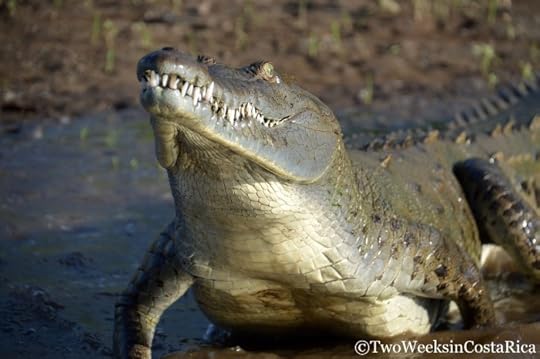
Shakira
José spotted several more crocodiles as we ventured farther up the river. We saw a short, stocky one named Danny Devito, another female called Nicole Richie, and even a small three-foot long baby basking in the sun. Everyone on the tour gasped as Jimmy jumped off the boat onto the riverbank to get closer to one of these intimidating creatures. Keeping his eye on a huge croc named Miley Cyrus, Jimmy slowly approached, stepping carefully through the mud and facing the croc the whole time. José told us that if Jimmy turned his back to the massive animal and tried to run, the seemingly lazy croc could spring into action and Jimmy would be in serious trouble. Luckily that didn’t happen and soon Jimmy was safely back in the boat. For us onlookers, it was amazing to be able to see these scaly beasts so close up in the wild, with our boat pulled right up next to them.
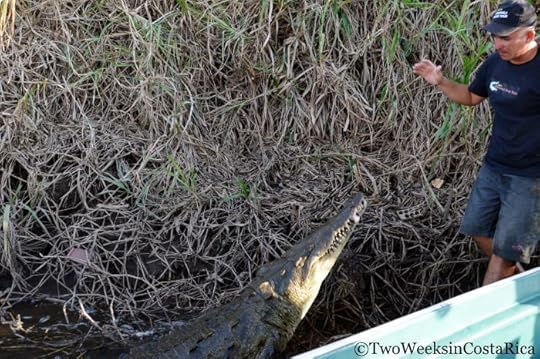
Jimmy getting a little close with Miley Cyrus
The Birds
The crocs were definitely a highlight of the tour, but as bird lovers, we also really enjoyed the birding. In the shrubs and trees along the riverbanks, José would point out different kinds of birds, many of which can be difficult to find in Costa Rica. He even called some of them in by whistling loudly. Crested Caracara, Black Hawks, Magnificent Frigatebirds, Anhinga, Snowy Egret, Black-bellied Whistling Ducks, Black-necked Stilts, Ringed Kingfisher, Northern Jaçana, and four types of Heron (Green, Little Blue, Great Blue, and Bare-throated Tiger) were just a few of the many we spotted. We were also fortunate to see some bright red, yellow, and blue Scarlet Macaw parrots flying overhead in pairs, which have an extremely limited range. José was very knowledgeable about the different species and even managed to turn up a Roseate Spoonbill later on in the tour, which had been on our must-see list for a long time. We learned that this rare avian is the only pink bird in Costa Rica and gets it color from eating shrimp.
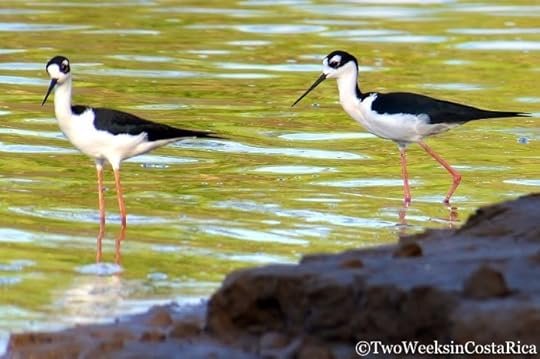
We didn’t get a great shot of the Spoonbill but these two Black-necked Stilts were very photogenic.
As the sun began to sink into the Pacific, we made our way up a narrow finger of the river. Thick mangroves surrounded us and the water turned to a shade of jade green. At one point, Jimmy slowed the boat to a crawl and steered into a passage with only a few feet to spare on each side. They wanted to show us the red mangrove crab, which can be seen on Costa Rica’s colorful five mil bill alongside a white-faced monkey and mangrove flower.
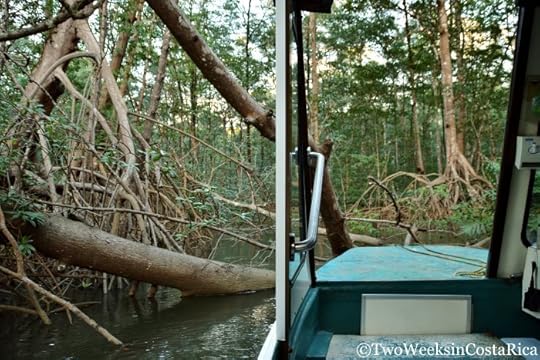
Sunset
The scenery during the entire tour was amazing. Mountains covered in green formed the backdrop, locals fished from the riverbanks, and cows eyed us curiously from under an umbrella ficus tree. Birds like White Ibis gathered in the tall mangroves, getting ready for nightfall.
As we headed back to the dock, we stopped in the middle of the river outlet for sunset. As a bonus, José’s 4 p.m. tour includes sunset and we were fortunate to have a spectacular one. The sky turned from clear azure to bright orange with a few wispy clouds. As the boat bobbed in the gentle waves, everyone made sure to get some photos to remember the day.

Information on Booking Your Crocodile Tour
Tour Times: 5 daily departures. Advanced reservations required. Contact José’s Crocodile River Tour to book and for more information.
Duration: 2 hours
Price: $35, includes water
Thanks to José’s Crocodile River Tour for hosting us on the tour. As always, all opinions are our own.
Have you ever taken a crocodile tour? What did you think?
The post A Riverboat Adventure with Jose’s Crocodile River Tour appeared first on Two Weeks in Costa Rica.
January 21, 2015
Llanos de Cortez Waterfall
Visiting a waterfall is on almost every traveler’s wish list. But for those heading to the northwestern part of Costa Rica, especially the beaches of Guanacaste, finding one of these magnificent cascades can be difficult. That’s because this region of the country is known to be more flat and dry, not exactly ideal conditions for a waterfall. Luckily though, there are some spectacular waterfalls hidden away. In this post, we’ll tell you about one gem near Liberia, the Llanos de Cortez Waterfall.

Location
The Llanos de Cortez Waterfall is located near the town of Bagaces, just a half hour south of Liberia and its international airport (LIR). It’s a short drive off the Pan American Highway (Route 1) and less than a two-hour trip from Tamarindo, Flamingo, Playa Conchal, and other beach towns in Guanacaste. These majestic falls are also a convenient stop for those traveling from the mountains near La Fortuna or Monteverde to those beautiful beaches of Guanacaste’s Gold Coast. For detailed directions, see the end of this post.
Tip: If you’re looking for something to pair with a visit to Llanos de Cortez, there’s a wonderful wildlife rescue center just a half hour south near Cañas. Read our post about Las Pumas Rescue Center for more information.
Access
Another draw of the Llanos de Cortez is that it is relatively easy to access. The parking area, which is just an open field, gets you very close to the waterfall. From there, it is just a short 10 minute hike down. The dirt trail is somewhat steep and has some rocks and roots to watch out for but is not too long. Sturdy sneakers or sandals like Keens are your best bet.

The Waterfall
Once you reach the bottom of the trail, you’ll see why Llanos de Cortez is considered to be one of Costa Rica’s most beautiful waterfalls. The falls are wide and wispy, with thin streams of water tumbling along the mossy rocks. Rocky cliffs are visible through the transparent cascade. To add to the grandeur, thick forest surrounds the falls with many birds and sometimes even monkeys bellowing from the trees.
At the base of the falls is a nice pool that is good for swimming or wading, and there is a sandy area to just hang out and relax. When we visited, there were even a couple of vendors set up serving cold drinks and snacks like grilled chicken kabobs.

If you’re up for a little exploring, you can walk along the banks of the gentle river to see wildlife like frogs and tadpoles, small fish, and the Jesus Christ Lizard, which got its name because it can actually run across the surface of the water. The more adventurous can traverse some rocks and get right behind the falling water to explore the shallow cave.
Tip: Water shoes with good grips would be nice to have here as the rocks are slippery and the bottom of the pool can be a little mucky.

Helping the Local Community
One of the best things about visiting the Llanos de Cortez Waterfall is that your visit helps support the local community. Shortly after you turn off the highway on your way to the falls, you will come to a small group of people asking for a donation. There is no admission fee to visit the waterfall; instead all donations go directly to the local school, Escuela de Llanos del Cortés. Many people don’t think of Guanacaste, with its developed beach towns, as an area that would need such support, but rural areas like this one have some of the highest poverty rates in the country. We donated $5 per person but any amount is appreciated and will go a long way for the local kids.
Directions to Llanos de Cortez Waterfall
From the North (Liberia)
Take the Pan American Highway (Route 1) south. Pass through Liberia and continue toward the town of Bagaces. As you drive south, look for a rustic sign for Catarata Llanos de Cortez and a dirt road on your right. This road will be about 20 km (12.5 miles) from the main intersection in Liberia. Once you turn off the highway (at the sign) follow the dirt side road. You will come to an intersection where you can give a donation for the local school. From there, take a right and continue about 5 minutes up the road to the parking area. Parking is $2, which pays for the attendant who watches over the lot. A 4×4 vehicle is recommended but many people make the trip in a regular car.
From the South (Cañas)
Take the Pan American Highway (Route 1) north. Drive past the main intersection for Bagaces, staying on the highway. As you drive north, look for a rustic sign for Catarata Llanos de Cortez and a dirt road on your left. This road will be about 25 km (15 miles) from the main intersection in Cañas. Once you turn off the highway (at the sign) follow the dirt side road. You will come to an intersection where you can give a donation for the local school. From there, take a right and continue about 5 minutes up the road to the parking area. Parking is $2, which pays for the attendant who watches over the lot. A 4×4 vehicle is recommended but many people make the trip in a regular car.
Hours
Llanos de Cortez Waterfall is open daily from 8:00 a.m. to 5:00 p.m.
* * *
The Llanos de Cortez Waterfall is one of Costa Rica’s most spectacular waterfalls and is also one of the easiest to access. Its convenient location makes it the perfect stop while passing by or paired with another activity in Guanacaste. Just an hour or so is all you’ll need to get in a swim in the refreshing water and fully experience the beauty of this stunning natural attraction.
Have you visited the spectacular Llanos de Cortez Waterfall or have questions about visiting? Leave us a comment below!
The post Llanos de Cortez Waterfall appeared first on Two Weeks in Costa Rica.
January 14, 2015
Nosara Trip Planning Essentials
At first glance, the town of Nosara might seem like little more than a tangle of dirt roads, some winding their way through lush jungle, others dead-ending or bringing you right back where you started. But take a closer look and you’ll see why so many people fall in love with this quirky beachside town. With a landscape of secluded coves, serene rivers, and vast tropical forests, Nosara is a place to escape, recharge, and discover where the next road leads.
This past year, we spent a couple of months living in Nosara and exploring everything this famous yoga-surfing destination has to offer. In this post, we’ll give you the essentials for planning your own visit, including our favorite activities, restaurants, and hotels.

Orientation
Nosara is located about halfway down the Pacific coast in a remote section of the Nicoya Peninsula. The closest international airport is Liberia (LIR), at about 2.5 hours away. Costa Rica’s largest airport in San José (SJO) is about 4-5 hours. From either location, the drive is along well paved highways for most of the way until about an hour outside Nosara when the road turns to rough dirt (four-wheel drive recommended).
Tip: If you’re flying into San José and aren’t up for the adventurous drive, you could always take a small plane directly to the airstrip in Nosara. Nature Air offers daily flights starting at $80 that will get you there in less than an hour.
Once you arrive, it won’t take long to discover Nosara’s unique layout. Unlike many of Costa Rica’s coastal towns, Nosara doesn’t have a main strip along the beach. Instead, the roads and businesses are set back from the ocean by a buffer of thick jungle. To get to the beaches, there are numerous offshoots that run perpendicular to the main road. One of the major ones brings you to Playa Guiones. This stretch has the largest concentration of shops and restaurants and you can walk to most places, including the beach. Other roads off the main way lead to Playa Pelada, another beach community just north, and the “Boca,” where the Nosara River empties into the sea. These sections are smaller and more spread out than Guiones but have some of Nosara’s best restaurants and hotels hidden among them. Following the main road inland toward the airstrip, you will find more practical amenities like a gas station, hardware store, and a larger grocery store. This area was the original town center and is still where a lot of the locals live and work.

The main road in Playa Guiones leading to the beach
Getting Around in Nosara
Because Nosara is so spread out, many travelers prefer to have their own transportation. When selecting a vehicle, keep in mind that the roads in and around Nosara are very rough. You’ll no doubt notice during your visit that most of the locals get around by motorcycle, ATV, or sturdy SUV. ATVs can be rented in town and if you need a rental car, be sure to check out our rental car discount.
Tip: If you’d rather not rent a vehicle, opt to stay in Playa Guiones, close to the center of town, to have the largest selection of restaurants and shops. If you want to venture out to Pelada or elsewhere, tuk-tuk taxis are always available and are by far the most fun way to travel!

What to Expect
Nosara might feel wild and remote, but it boasts an impressive array of amenities. Built into the thick jungle, you’ll find gourmet health food shops, bakeries, surf schools, yoga studios and wellness retreats, spas, boutique hotels, and restaurants serving cuisine from all around the world. Because these businesses cater to travelers and the large expat community, prices tend to be on the higher side for Costa Rica.
Activities in Nosara
As for activities, Nosara is best known for surfing and yoga, but offers plenty of other things to do as well. Here’s a short list of some of the most popular activities and attractions.
Surfing and SUP
If you’re coming to Nosara for the waves like a lot of people do, your first stop will probably be Playa Guiones. Guiones is Nosara’s most popular beach because it has a beach break that can be surfed almost any time of day. Another good spot for the more experienced is Playa Pelada. If the tide is right, Pelada has a nice wave that breaks off the rocky point and sometimes the locals will even jump right off the rocks and onto their boards to catch the waves.
If you’d rather spend some time relaxing on the water, take a SUP tour up the beautiful Río Nosara. Along this calm river, you can paddle through thick mangroves to see birds and other wildlife.
Horseback Riding
With its roots in farming, and some cattle ranches still in operation today, it should be no surprise that horseback tours are one of Nosara’s most popular activities. Several operators offer these excursions, and the view of the jungle and beach from atop a horse is an experience you won’t want to miss.
Tip: We went riding with Boca Nosara Tours and loved it. They take great care of their horses and the guides are super friendly. Check out our post the Pure Life Pace: A Horseback Tour in Nosara for more.
Yoga
Peaceful rainforest surrounds, singing birds, waves lapping the shore, and outstanding sunsets are some of the key elements for the ultimate yoga escape—and all can be found in Nosara. Whether you’re a full-on yogi or are just giving it a try, work on your mind-body connection at one of the many studios in town. Nosara helped put Costa Rica on the map as a top yoga destination with its world-renowned Nosara Yoga Institute. This center provides professional training for yoga instructors from around the globe and is a great place to take a class.
ATV and Off-Road Tours
Join the locals and kick up some dust of your own in an ATV or off-road TOMCAR. These tours are available through many different operators in town and take you into the nearby hills, through rivers and to waterfalls, all while giving you some great ocean views.
Wildlife and Bird-Watching
Wildlife, especially howler monkeys, can be seen throughout town, but if you want a closer look, there are a few places to check out. The Nosara Biological Reserve is a private 35 hectare (90 acre) reserve managed by the Lagarta Lodge and is a great place to see monkeys, lizards, land crabs, and up to 270 species of birds, including the Long-tailed Manakin and Turquoise-browed Motmot.
Nosara also has a couple of amazing wildlife centers that help howler monkeys and other animals that have been injured or abandoned. Refuge for Wildlife and Sibu Sanctuary, together as the Nosara Wildlife Center, offer tours of their facilities. Recommended donations are $50 per person and all proceeds go towards helping the animals.
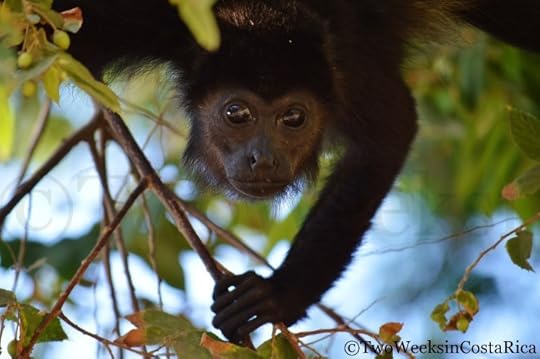
Howler Monkey hanging out in Nosara
Restaurants in Nosara
Il Pepperone
As the name implies, this open-air restaurant on the way to Playa Pelada is the place to go for delicious Italian cuisine. The wood-fired pizza is memorable and the seafood and homemade pasta dishes (try the gnocchi!) are very good as well. Il Pepperone also makes a strong margarita for those looking to let loose.
Pacifico Azul
For the freshest seafood, head to Pacifico Azul. The main menu has many standard dishes, but the daily specials are what make this restaurant stand out. Check the chalkboard to see what the local fishermen have brought in that day, and get there early for the most choices. Pacifico Azul recently moved into the space at the Guilded Iguana Hotel, near the northern end of Playa Guiones, so look for them there.

Fishermen down at the Boca bringing in the local catch
Rancho Tico
If you want a taste of authentic Costa Rican cuisine, head to Rancho Tico. This restaurant and bar in the original part of Nosara (near the airstrip) is a popular hangout for locals and tourists alike. Rancho Tico is great for larger groups and they have a huge menu that will please everyone, even the kids. Traditional dishes like casados (rice and beans with meat and salads) are typically enjoyed at lunch, and beef, chicken, or fish dishes with delicious sauces are popular for dinner.
Burgers and Beers
Costa Rica’s craft beer movement is still in its infancy, but Burgers and Beers has some delicious brews that you’ll be hard-pressed to find anywhere else in the area. This place is a little pricy, with burgers around $14 apiece, but they’re huge. If you’re on a tight budget, you could always split one and order an extra cerveza or two.

Olga’s
Right on the beach at Playa Pelada, Olga’s is a local favorite that has been around for years. It’s super casual, but is a great spot to grab a beer and watch the surfers and beachgoers cruise by. We highly recommend the patacones (fried plantains) with guacamole.
Seekret Spot
For a cool treat in the heat of the day, check out Seekret Spot on the road to Playa Pelada. This tiny place makes homemade gelato in flavors like maracuyá (passion fruit), coco (coconut), tiramisu, and deep dark chocolate. As a bonus, on Saturday afternoons there is an organic farmers market right across the street.
Hotels in Nosara
Below we give our recommendations for hotels, B&Bs, and lodges. Keep in mind, though, that Nosara also has a wide selection of vacation rentals, which might be a better option for families and groups. VRBO and HomeAway are good places to search for a vacation rental, with over 100 listings to choose from.
Something else to consider when deciding where to stay in Nosara is location. Like we said above, you don’t need a car if you’re in the main area of Playa Guiones, but you will probably want one if you’re in Playa Pelada or Boca Nosara.
High End Hotels ($200+)
Harmony Hotel
Eco-luxury might be the best way to describe the exquisite . Using sustainable practices but still devoted to keeping things upscale, it’s the little things at Harmony that will make you feel pampered. Cocktails served with bamboo straws, shampoo and bodywash made from local flowers, organic cotton sheets, and native tropical gardens surrounding the pool are just a few examples. $300-700. .
L’Acqua Viva Resort and Spa
Built in a style that pays homage to Costa Rica’s indigenous cultures, the structures and architecture of L’Acqua Viva are what make this resort unique. Lofty ceilings, open and airy gathering places, beautiful natural feeling pools, and native wood all around give a simplistic, back-to-nature feel. And even with its elaborate furnishings and air conditioned rooms, L’Acqua Viva still ties seamlessly into its jungle backdrop. $165-700. Check Availability and Prices Here.

Inside one of the airy bungalows at L’Acqua Viva. Photo Credit: L’Acqua Viva Resort & Spa Resort
Mid-Range Hotels ($125-200)
Teak Pacific Hotel
Conveniently located near Playa Pelada and some of the restaurants listed above, Teak Pacific has a great location and nice setup. The roomy casitas are fully equipped with kitchens and comfortable living rooms. The property is also nicely landscaped and there is a pool if you don’t feel like strolling down to the beach for a swim. $139-209. Check Availability and Prices Here.
Hotel Luna Azul
Luna Azul is located about 15 minutes north of Nosara, closer to the famous turtle nesting beach of Playa Ostional. This boutique-style lodge has 7 private bungalows, each with an outdoor shower and large terrace (some with ocean views). The owners are what make this place special, though, with their gourmet cooking and personal approach. Since it is outside town, a rental car is definitely recommended. $120-215. Check Availability and Prices Here.

Hotel Luna Azul, near Playa Ostional. Photo Credit: Hotel Luna Azul
Nosara Yoga Village at the Nosara Yoga Institute
If you’re coming to Nosara for yoga, this is one of the best places to stay. The Yoga Institute has been internationally recognized for its training courses but now has opened its doors to the public. Rooms range from single beds with shared baths to executive suites with king beds. Packages include daily yoga classes, three vegetarian or vegan meals a day, and access to an Olympic-size saltwater lap pool. $120-360. Check Availability and Prices Here.
Budget Hotels ($125 or less)
Giardino Tropicale
A good choice for surfers, Giardino Tropicale is an affordable option within walking distance to Playa Guiones and the center of town. The hosts are known for their friendliness and willingness to give local recommendations. There is also an Italian restaurant on the property that has delicious wood-fired pizza. $75-120. Check Availability and Prices Here.
Villa Mango B&B
Located on a hill near Playa Pelada, Villa Mango has sweeping jungle and ocean views, a saltwater swimming pool, and warm décor throughout. This charming B&B is definitely a great deal for the area. $49-125. Check Availability and Prices Here.
Hotel Lagarta Lodge
A very nice, affordable hotel a little outside town is Lagarta Lodge. This small lodge is located quietly on a hill in Boca Nosara with great views of the Río Nosara and Nosara Beach. It also abuts a rainforest-filled nature reserve with trails for walking. The owners are friendly, and there’s a pool and on-site restaurant with great food. $60-125. Check Availability and Prices Here.
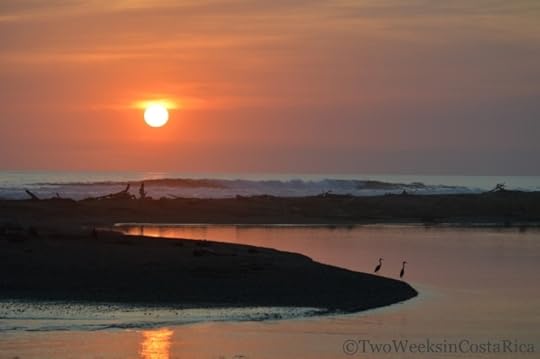
Sunset in Boca Nosara
Nosara might not seem like an idyllic vacation getaway right away, but spend some time exploring and you’ll start to discover small pieces of paradise. Hidden beaches, secluded jungle trails, gorgeous lookouts, and even gourmet cuisine. The road, though sometimes long and dusty, really does lead to paradise.
Are you planning your trip to Nosara? Let us know if you have questions in the comments below.
The post Nosara Trip Planning Essentials appeared first on Two Weeks in Costa Rica.

